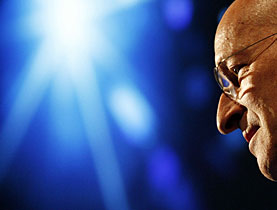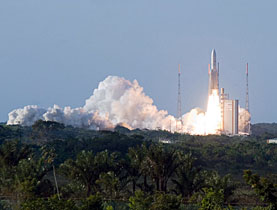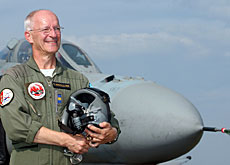Swiss astronaut shares memories of moon landing

Switzerland's only astronaut was among millions of people around the world to witness the historic Moon landing on the night of July 20-21, 1969.
Claude Nicollier tells swissinfo.ch that when Neil Armstrong and Buzz Aldrin took their first steps on the Moon 40 years ago it was like a childhood dream come true.
Nicollier joined the United States space agency, Nasa, in 1980 to become a member of the team of future space shuttle specialists.
He later took part in four shuttle flights, logging more than 1,000 hours in space. He flew as a mission specialist in 1992, 1993, 1996 and 1999.
swissinfo.ch: Where were you when Neil Armstrong set foot upon the Moon and what are your memories of that moment?
Claude Nicollier: I was 24 at the time and was a pilot for the Swiss Air Force. I spent that night watching television, black and white, at my aunt’s place in La Tour-de-Peilz, on Lake Geneva.
I remember we waited a long time for Armstrong to finally climb out of the Lunar Module. Then there was this magical, magnificent moment.
The French Tintin comic book was the first to ‘take us to the Moon’ [he laughs]. But that night in July it was for real: a childhood fantasy become true.
swissinfo.ch: You took part in four space missions. What’s it like to be “up there” on the borders to infinity?
C.L.: I never went as far as the astronauts from the Apollo programme. When you find yourself orbiting in space around the Earth, about 6,000km away from our planet, you feel fantastic.
It is wonderful to be suspended in gravity and be able to admire the Earth from the sky.
Beyond the aesthetic beauty of this extraordinary sight, I felt satisfaction because it justified the work we do in space, in particular our mission to repair the Hubble telescope. Hubble is extremely valuable for science and astronomy. It was a privilege for me to fix it.
swissinfo.ch: There were six manned missions to the Moon in just four years. Did fascination with the Moon wane as interest in Mars grew?
C.L.: I don’t think so. It was the goal of the Apollo programme to be the first on the Moon before the Russians got there. There were setbacks – technological, scientific and operative – but the aim was clearly political.
Not least for financial reasons it was decided to suspend further manned missions after six landings on the Moon. Afterwards the focus was mainly on missions in the Earth’s orbit.
swissinfo.ch: Some critics, notably Bill Kaysing who worked for a company supplying components for the Apollo shuttle, say man never made it to the Moon. Is it possible that one of the greatest achievements of mankind was staged for the screen?
C.L.: From an intellectual point of view it makes sense to question everything. Did Hillary and Tenzing ever reach the top of Mount Everest in 1953?
There is evidence to prove that achievement. But it is much more difficult to prove the lunar experience, because it is so far away.
For my part, I do not have the slightest doubt that man walked on the Moon and that the Apollo mission happened the way we all know it.
swissinfo.ch: Nasa wants to take more people to the Moon by 2020 and does not rule out setting up a permanent base there. Is it possible to colonise the Moon?
C.L.: The Moon might be useful as a base in space for scientific purposes. Still I would not use the term ‘colonise’. I don’t think a large group of people will live on the Moon, at least not in the near future.
The atmosphere on the Moon is no doubt very beautiful. Aldrin [the astronaut who accompanied Armstrong] described it as ‘magnificent desolation’, but it remains hostile territory.
swissinfo.ch: And yet there are private companies which offer trips to the Moon for tourists…
C.L.: I don’t mind that as long as it is a form of sustainable tourism. I think the possibility to travel to the Moon should not be limited to astronauts: it is such an extraordinary experience.
swissinfo.ch: The Moon could also be attractive for its resources, namely Helium-3. What is the real potential and could it help save the energy problems on Earth?
C.L.: It is a highly controversial issue as the use of the lunar gas helium is very expensive. We have to see how the energy situation develops on Earth.
It could be very appealing to exploit the lunar gas Helium-3 [as a second-generation fusion power source] if nuclear power were to become much more important.
The time for building huge infrastructure on the Moon has not come yet. But I think it is conceivable to set up a transport system between the Earth and the Moon in the future and to keep the costs within reason.
swissinfo.ch: We have enough problems with the current economic crisis, poverty, armed conflicts and pollution. Why spend money to explore the Universe?
C.L.: Space has opened up doors to many things. Our lives would be different without research in space. Just think of telecommunications.
Financially speaking the costs of space exploration are relatively limited. Nasa’s annual budget is $17 billion (SFr18.4 billion). This is peanuts compared with the amount that goes towards programmes to bail out the American carmaker General Motors or the Swiss bank, UBS.
Going into space always means looking at the planet Earth. Most of the annual SFr140 million contribution of Switzerland to the European Space Agency comes back in the form of business deals and translates into jobs. In other words: it’s money well spent.
Luigi Jorio, swissinfo.ch (adapted from Italian by Urs Geiser)
American astronaut Neil Armstrong became the first human to walk on the Moon on July 20, 1969 at 9.56pm Cape Canaveral, Florida, time (Swiss time 3.56am, July 21, 1969).
To commemorate the historic mission the crew of Apollo 11 left a stainless steel plaque on the module Eagle on the Moon with information for other beings (human or otherwise): Here Men from the Planet Earth first set foot upon the Moon July 1969, A.D. We came in peace for all mankind.
A total of 12 astronauts walked on the Moon between 1969 and December 1972.
Born in 1944, Nicollier received a Masters in astrophysics from Geneva University in 1975.
He began his career as a pilot in the Swiss Air force in 1966, reaching test pilot status in 1988. He also worked for the former national carrier, Swissair, in the 1970s.
He joined the European Space Agency in 1976, before being chosen as one of its first astronauts in 1978. He was attached to the American space programme in 1980, joining Nasa’s team of future space shuttle specialists.
He later took part in four shuttle flights, logging more than 1,000 hours in space. He flew as a mission specialist in 1992, 1993, 1996 and 1999.
During his last mission, he took part in repairing the Hubble space telescope, spending over eight hours walking in space.
He teaches spatial engineering at the Lausanne Federal Technical Institute of Technology.
Alongside Bertrand Piccard he is involved in Solar Impulse, a project to build the first solar-powered aircraft.
All celestial bodies, including the Moon, are common property of mankind, according to the Outer Space Treaty signed by the US, the Soviet Union and Britain in 1967. Therefore no state can claim sovereignty.
Several private companies have been offering space flights to the Moon at a cost of about €80 million.
They also began selling lots of the Moon surface. An Israeli firm set the price at €100 per hectare.

In compliance with the JTI standards
More: SWI swissinfo.ch certified by the Journalism Trust Initiative















You can find an overview of ongoing debates with our journalists here . Please join us!
If you want to start a conversation about a topic raised in this article or want to report factual errors, email us at english@swissinfo.ch.